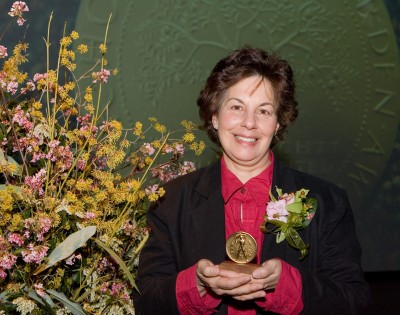Nina Bassuk One on One
On Saturday, March 15th at the Scott Arboretum’s Annual Spring Festival we presented Nina Bassuk with the Scott Medal and Award. I spoke with Nina over the phone and asked her a few questions about her illustrious career.
Liz: You have focused much of your career on research and education for the betterment of urban areas through planting trees. I live in Philadelphia, which, along with the rest of southeastern Pennsylvania, has seen a drastic reduction in heavy tree cover over the past several decades. I also used to live in New York City; so personally, I know the impact that a tree-lined street can have on an urban environment and its inhabitants. Can you tell us how you were inspired to do the work that you do?
Nina: I didn’t start out being interested in horticulture as a career at all. I was interested in music but my hobby was always growing plants. My real focus was music in college. I grew up in New York City and had an urban childhood without a lot of green grass or flowers and with a postage stamp sized front yard. I had a desire to see things grow and I tried to grow things in pots under lights in my room. I started to propagate things in the kitchen: making cuttings, dividing things. I decided I wanted to make my hobby my career, and it seemed right! When I was growing up, there were no role models of women in agriculture or horticulture. It wasn’t a career path. But I transferred to Cornell and got excited about why things happened and how an environment can change the way that plants respond.
Liz: Urban trees face a lot of challenges: poor drainage, sites not built for tree plantings, vandalism, urban microcosms and pollution. If you were to pick the biggest stress that most urban trees face, what would it be and why?
Nina: The biggest stress would be compacted soil, no question about it. It’s a domino effect: the compaction leads to loss of structure, poor drainage, lack of oxygen, dense soil that microorganisms can’t live in. Compaction happens because of developments of streets, heavy equipment, and construction; all things that are prevalent in an urban environment.
Liz: I know you are on the Vegetation Technical Subcommittee for the Sustainable Sites Initiative, which is an initiative to guide those who want to create sustainable landscapes. Can you tell us a little bit about your work with this group?
Nina: This project is a monumental undertaking. There are 5 subcommittees with experts from all over the country. We meet by conference call and have discussions about basically creating guidelines for landscapes that are similar to LEED’s (Leadership in Energy and Environmental Design) for buildings. LEED is incorporated into it, as well as the ASLA, and the Green Building Council. Buy-on with other organizations with national recognition has been really important in terms of giving this project the biggest impact possible. We are creating guidelines and goals for people building landscapes based on sustainable principals. These landscapes will get points just like buildings do for LEED certification. The more you can do to create beneficial ecosystems in a landscape, use less resources and creating greater eco-system services, the more points the landscape will get. In about a year and a half there will be guidelines in place for people creating landscapes who wish to make them sustainable. The hardest part has been figuring out how to measure and make grades for this. But this project has the potential to be very important in terms of moving landscapes along in the direction of LEED. These guidelines will be applicable for any sized landscape, botanic garden, municipal, residential, large landscape restoration, and even a green roof. That’s what has been most difficult, encompassing all the kinds of sites that people create.






No Comments